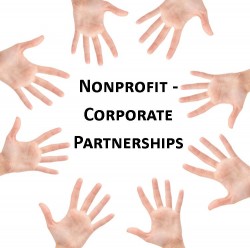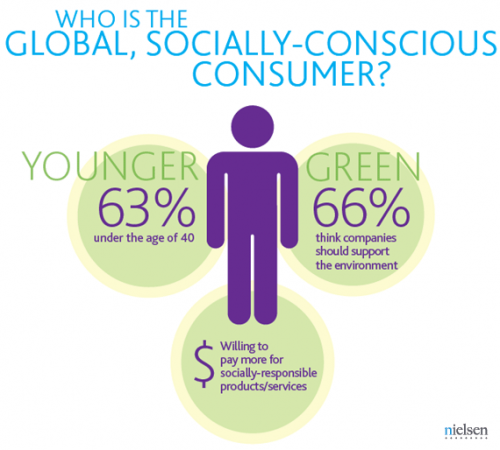Corporate Philanthropy
Millennials want to engage with their employers through cause work. It’s that simple. And, they are influencing their workplaces and the causes they support.
That becomes even more evident with the latest 2014 Millennial Impact Report from Achieve. Approximately 80 million Millennials live in the U.S. today, collectively spending about $300 billion annually on consumer discretionary goods. And, by the year 2020, they will make up 50% of the workforce!
So, let’s get down to it and see just how influential they are. Continue reading
Let's connect!Why not share this?
The CECP, in association with The Conference Board, released its Giving in Numbers: 2013 Edition. Based on data from 240 companies, including 60 of the largest 100 companies in the Fortune 500, the sum of contributions across all respondents in the 2012 survey totaled more than $20 billion in cash and in-kind giving!
Some tidbits of information:
- Median total giving in CECP’s sample was $20 million
- 59% of companies gave more in 2012 than in 2007, the year before the global recession set in
- Aggregate giving rose 42% from 2007 to 2012
- While direct cash donations dominated at 47% of total giving in 2012, non-cash contributions have been growing at a faster rate of 10% or more in each year since 2008
- Paid-release-time employee volunteer programs were offered by 70% of companies in 2012, compared to just 53% of companies before the global recession
Here’s the infographic that details the report’s result: Continue reading
Let's connect!Why not share this?
 Corporate philanthropy in the U.S. represented 6% of total charitable giving in 2012, totaling about $19 billion. Cause marketing and sponsorship came to $1.68 billion.
Corporate philanthropy in the U.S. represented 6% of total charitable giving in 2012, totaling about $19 billion. Cause marketing and sponsorship came to $1.68 billion.
Even though these numbers represent a low percentage of all monies raised for charitable causes, it’s still welcome chump change for the nonprofit sector. Plus, it gives companies a way to engage their customers, increase brand loyalty, and boost sales.
Many of the larger charities have embraced cause marketing partnerships with major-league corporations. Examples include:
- Denny’s and America’s Egg Farmers have partnered to help end childhood hunger in the U.S.
- Kia Motors America and DonorsChoose.org launched a Back-to-School giving campaign.
- CIBC (bank) in Canada has been the title sponsor of the Canadian Breast Cancer Foundation Run for the Cure for years.
Smaller businesses and nonprofits have also benefited from partnering. Check your favorite retailers or service providers and you’re bound to find a variety of programs.
So, how do these relationships form?
Typically, the charities approach select businesses to explore partnerships. There’s a right and wrong way of doing this. Those that employ corporate relations professionals can fare quite well, while others do it very poorly.
I remember when C. A. Howlett, the current president of US Airways Community Foundation, came to speak at a fundraising association luncheon I attended. He literally blasted the audience for their inconsiderate and unprofessional behavior in wooing and working with the airline. He shared a few horror stories that made my eyes roll.
Then, this week, I read Christy Duncan Anderson’s blog post entitled, “6 Tips on How to ‘Partner’ with a Corporation.” Anderson is executive director of The Safeway Foundation. Here’s an excerpt:
Monday morning. An email (labeled with high importance) comes in from a nonprofit and a person I’ve never met:
‘Dear Ms. Duncan Anderson, we are (a very important charity) and we want to explore a partnership with you. My CEO would like to speak to you next Wednesday morning or Thursday afternoon. Please let us know which of these works better in your schedule.’
They want a ‘partnership’ with me?”
Read the rest to get the picture. Anderson offers six tips on how to partner with a business. And, I’m going to offer one tip on how to avoid blowing it.
How to Avoid Blowing Nonprofit-Corporate Partnerships
Nonprofits: Lose the right of entitlement attitude. You may have the best cause, but so do millions of other nonprofits. No one owes your organization anything.
Added value: Be humble. Do your homework. Be professional. Use your business head. And, don’t make assumptions.
Do you have any more recommendations to add or experiences to share?
Let's connect!Why not share this?
 A new study from Charities Trust in the UK says we should expect major changes in how companies approach community involvement and corporate giving over the next few years. The study predicts that companies will abandon charities that fail to deliver. Deliver what, I ask?
A new study from Charities Trust in the UK says we should expect major changes in how companies approach community involvement and corporate giving over the next few years. The study predicts that companies will abandon charities that fail to deliver. Deliver what, I ask?
Charities that can’t deliver success, or at least prove progress, will lose their corporate supporters unless they start developing their survival plan now.”
Linda Minnis, CEO, Charities Trust.
What I find most interesting is that companies will “want their charitable causes run like businesses, and, alongside meeting targets and delivering results, they will be expected to have a positive impact on company profits too.”
Just because a business contributes to a charity or cause with cash donations, staff volunteering, and in-kind contributions, expecting its chosen nonprofits to positively impact company profits is unrealistic. Supporting a charity and expecting it to steward that money well is not equivalent to investing on the stock exchange and expecting a return on investment.
Now, if these corporate-nonprofit relationships were based on cause marketing, then that’s a different story. Cause marketing partnerships typically involve a specific campaign, sometimes with a designated time frame, and often with a written agreement of deliverables on both sides. It’s expected that companies want to boost their sales and/or brand reputation by connecting with a charitable cause. It should be a transparent win-win relationship.
Cause Marketing Examples:
Save Lids to Save Lives: Yoplait and Susan G. Komen for the Cure
Yoplait runs its breast cancer campaign during October’s Breast Cancer Awareness Month. For each pink lid received and each code redeemed online, General Mills donates 10¢ to Susan G. Komen for the Cure, up to $2,500,000. In 2013, the company expanded to include many of its other brands like Green Giant, Hamburger Helper, Progresso, Honey Nut Cheerios, Cinnamon Toast Crunch, Fiber One, Total, Nature Valley, Pillsbury, Betty Crocker and Bisquick.
Phones for Good: TELUS and Free the Children
TELUS donated $25 to Free the Children from the sale of designated phones during a social media campaign. Phone sales rose 29% above forecast, and TELUS gained more than 30,000 Facebook fans.
Although Minnis reports that we can expect more collaboration between competitor companies and co-related charities for common causes, she also predicts that, “Charities should prepare themselves for a seismic change in how they go about attracting and retaining support from the corporate world.”
I have always promoted running charities more like businesses, because they can achieve so much more for their missions. Collaboration and longer-term business-nonprofit partnerships are also a good thing. My concern is that charities will feel additional pressure to satisfy corporate philanthropists’ expectations to positively impact company profits in order to acquire and retain their support.
But, is that fair? What do you say?
Source: “What’s next for corporate fundraising?,” The Guardian
Let's connect!Why not share this?
 Do you prefer to buy products and services from companies that implement programs that give back to society? This was the question Nielsen asked of 28,000 online respondents last March from 56 countries worldwide. And here’s what it discovered:
Do you prefer to buy products and services from companies that implement programs that give back to society? This was the question Nielsen asked of 28,000 online respondents last March from 56 countries worldwide. And here’s what it discovered:
- 66% of consumers around the world say they prefer to buy products and services from companies that have implemented programs to give back to society
- 62% prefer to work for these companies
- 59% invest in these companies
- 46% say they are willing to pay extra for products and services from these companies
So, who are these socially conscious consumers? Mostly the younger generation: 63% are under the age of 40; 51% of all respondents aged 15 to 39 are willing to pay extra for such products and services.
And, the most socially conscious country? The Philippines where 68% of respondents said they were willing to pay extra for products and services from companies that had implemented programs to give back to society.
And the least? The Netherlands, where 20% of respondents indicated their willingness to pay extra for these products and services.
The survey results also indicated that socially-conscious consumers care most about environmental sustainability, followed by improvements to science, technology and math education and eradicating extreme poverty and hunger.
So, the big question is… are YOU a socially conscious consumer? What’s your socially conscious consumer IQ?
Now, there’s a short online quiz from McKinsey & Company that can help you answer this question. Take it and find out.
Let's connect!Why not share this?
 We have a day for giving thanks. We have two for getting deals…. Wouldn’t it be great to have a day for giving back?
We have a day for giving thanks. We have two for getting deals…. Wouldn’t it be great to have a day for giving back?
That’s the premise for Giving Tuesday, a concept developed by New York’s 92nd Street Y. It has been the catalyst and incubator for #GivingTuesday, bringing the expertise of 139 years of community-management to the project, and providing #GivingTuesday a home.
The United Nations Foundation joined as partners, bringing their strategic and communications clout to the project. An amazing team of influencers then offered their ideas, contacts and wisdom to help shape and improve the concept. A powerful list of corporations and non-profits agreed to be founding partners, helping spread the word and committing to their own #GivingTuesday initiatives. And, since then, countless organizations, friends and leaders have all added their support and talents to make #GivingTuesday a reality. But what really matters is YOU. #GivingTuesday relies on people everywhere playing their part to make it a real success.”
Mission Statement:
#GivingTuesday™ is a campaign to create a national day of giving at the start of the annual holiday season. It celebrates and encourages charitable activities that support nonprofit organizations.
Want some ideas to honor this day at your place of business or individually? Read more here.
So, how will you support the first annual Giving Tuesday?
Let's connect!Why not share this?
 Guest post by Ashley M. Halligan
Guest post by Ashley M. Halligan
Cause marketing relationships between nonprofit organizations (NPOs) and for-profit businesses (FPBs) have produced mutually beneficial synergies time and time again. The benefits of establishing lasting relationships between NPOs and FPBs can be significant for both parties.
The nonprofit can advance its mission through association and partnership with a recognized business, without investing its own limited resources. The business can raise brand awareness, demonstrate social responsibility, and boost customer interest in its products or services. In fact, a 2010 Cone Inc. study cites that 80% of Americans are willing to switch brands – of equal quality and nature – if a brand supports a good cause.
 But how does a nonprofit begin the search for a lasting relationship with a business? I spoke with several industry experts, from both NPOs and FPBs, to determine what steps a nonprofit organization should take to begin and ultimately achieve an enduring cause marketing relationship.
But how does a nonprofit begin the search for a lasting relationship with a business? I spoke with several industry experts, from both NPOs and FPBs, to determine what steps a nonprofit organization should take to begin and ultimately achieve an enduring cause marketing relationship.
- Develop a Shortlist of Potential Business Partners - Keeping in mind positive public visibility and aligned missions and/or philosophies will help you accrue a list of prospective partners. Also, assess how you may be able to mutually benefit each other. It’s not necessary to specifically define these benefits in advance, but considering what you can offer each other will make future conversations more seamless.
- Begin Some Conversations - Once you’ve selected a handful of prospects to reach out to, finding the right person to contact within a company is important. Take a look at your organization’s members; can someone provide a contact with a prospective company and open the door for communication and provide an introduction? If so, take that approach. Otherwise, find a person within the company with whom you can develop a relationship.
- Initiate and Nurture the Relationship - It’s important to keep in mind that while you’re establishing a business relationship, you’re also creating a personal relationship. Communication is key. Keep the for-profit company up to date on all endeavors and reports so you can continually demonstrate its return on investment - whether that be funding, volunteer hours, or co-marketing visibility. A lasting synergy comes along with measurable mutual benefits.
How has your company or organization developed successful cause marketing partnerships? Share your experiences and suggestions!
……………………………………………………………………………………………………………………………..

Ashley M. Halligan is a property management analyst at Software Advice in Austin, Texas. She specifically focuses on covering best practices, what-to-know and industry trends of the property, facilities and maintenance management markets. You can connect with Ashley on Twitter: @PMAdvice
Why not share this?











